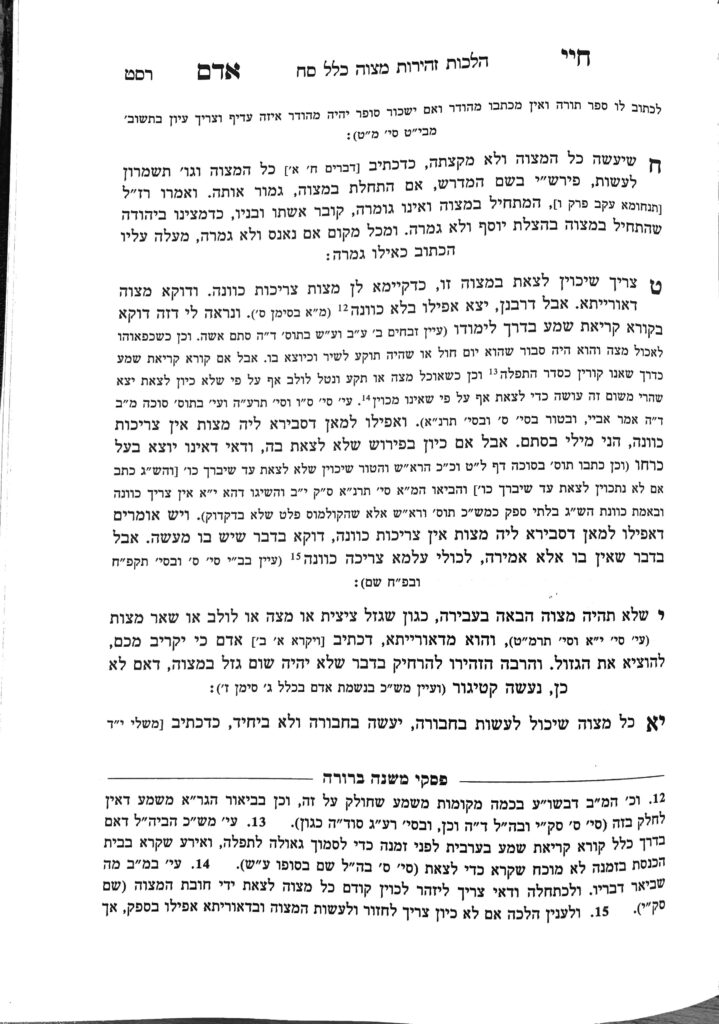We are continuing in siman 8, which discusses the concept of hamaschil b’mitzvah omrim lo g’mor, that a person should not stop in the middle of a mitzvah but should complete it. We left off pointing out that there is no explicit halachic discussion in the Gemara about this concept, only an aggadic discussion. However, the Gra suggests a source.
In siman 581, the Rema writes that whoever davens selichos for the amud should daven shacharis and mincha as well on that day. The Magen Avraham explains that the reason for this minhag is due to the concept of hamaschil b’mitzvah omrim lo g’mor. The Gra points out that there is a Gemara in Brachos 43a which appears to support this concept. The Gemara there states that when a group of people wished to drink wine, if the group had not yet begun eating, one person would make a bracha to exempt everyone else. (However, during the meal itself, every person would make the bracha themselves. If one person is being motzi others, we are concerned that when the listener needs to recite amen, they will choke while trying to respond.) The Gemara continues, and says that if the group had one person make the bracha on wine for everyone, that person should make the bracha on the mugmar, which was a nice-smelling collection of incense burnt after a meal. The Gra suggests that the reason for this halacha is due to our concept of hamaschil b’mitzvah omrim lo g’mor.
Another example of this concept is that the person who blows the tekiyos d’meumad, the tekiyos blown before shemoneh esrei, should blow the tekiyos d’meyushav, the tekiyos blown after shemoneh esrei.
It is brought down that when Rav Chaim Brisker would receive a Sefer Torah for a hakafa on Simchas Torah, he would hold onto it for the entire hakafa, due to our concept of hamaschil b’mitzvah omrim lo g’mor.
Our minhag is not do so. The sefer Binyan Shlomo writes that when the tekiyos were initially divided between two people, such that one person will blow the tekiyos d’meumad and another will blow the tekiyos d’meyushav, the concept of hamaschil b’mitzvah does not apply, because each person fulfilled his full mitzvah as it was given to him. We could apply this concept to hakafos as well.
There are a few Gemaras which seem to indicate that if one sets up initially to divide a mitzvah, there is no issue of hamaschil b’mitzvah. For example, the mishnayos in Yoma discuss how the kohanim would divide certain jobs of the korban tamid, even though technically one person could do the entire avodah. The Gemara discusses how one group of kohanim would bring the parts of the korban to the bottom of the mizbeach, and others would bring them to the fire on top. There is no issue of hamaschil b’mitzvah because each kohen was initially only given a specific part of the mitzvah, so each kohen fulfilled their entire mitzvah as it was given to them.
Rav Chaim Kanievsky ztl writes that if one begins a masechta, they should finish it as well, due to this concept.
Summary
The concept of hamaschil b’mitzvah can be applied to blowing all of the tekiyos on Rosh Hashanah, or holding onto a Sefer Torah for the entirety of a hakafa. However, if the mitzvah is initially set up in a way that it will be divided between multiple people, there is no issue of hamaschil b’mitzvah, because the part of the mitzvah given to each individual is considered their entire mitzvah.



